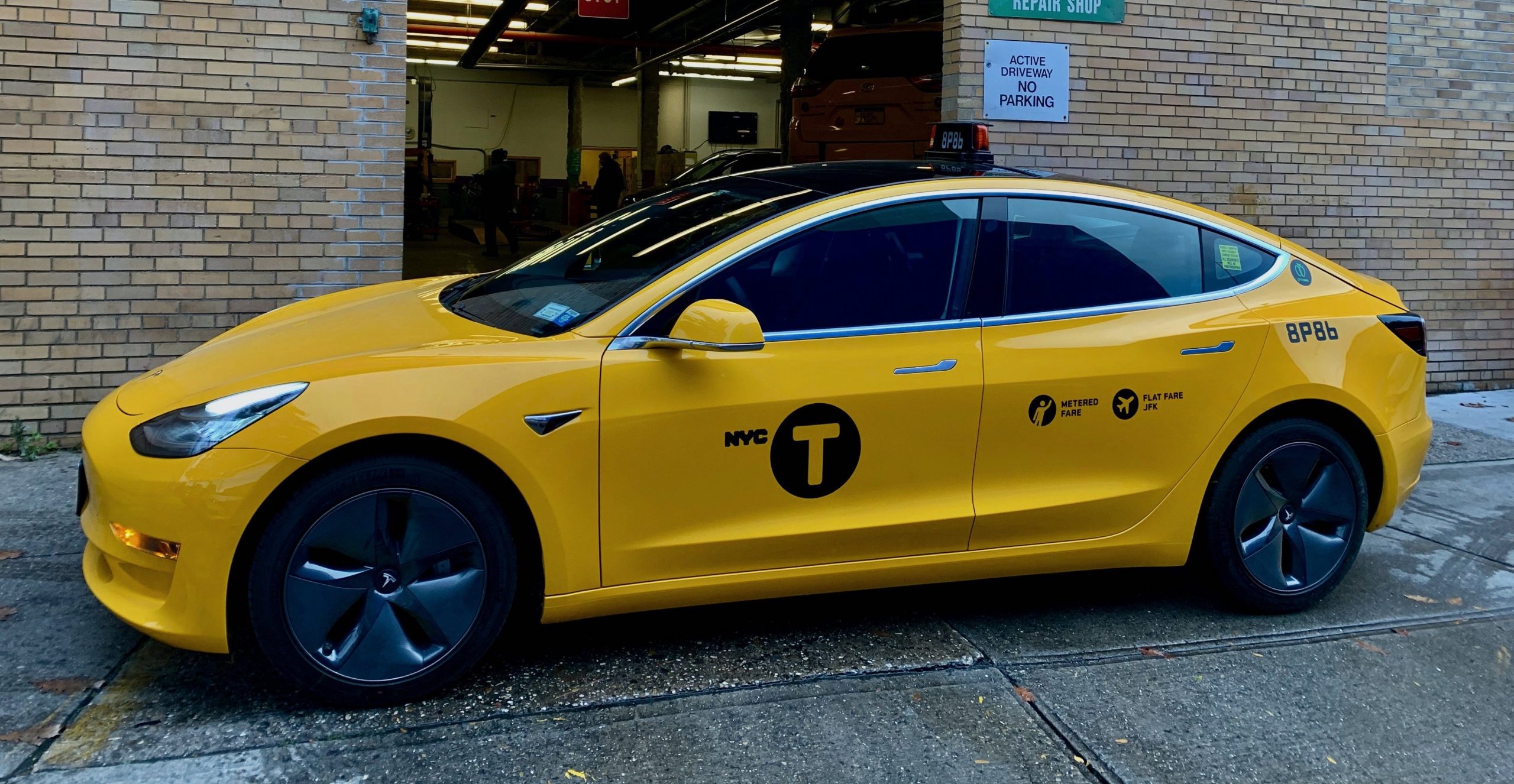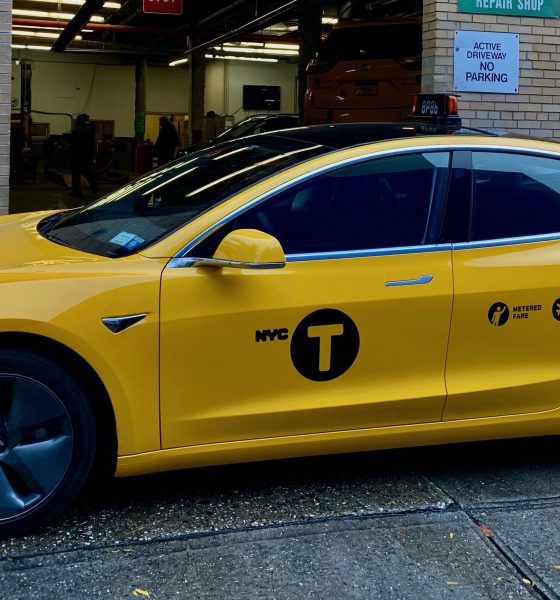

News
Tesla Model 3 wins hearts as famed NYC Taxi, picks up where Nissan Leaf couldn’t
Images of a Tesla Model 3 being used as a New York City taxi cab, complete with the fleet’s iconic yellow paint scheme, have started making the rounds online. The vehicle, which was sighted in Manhattan near a Tesla store, signifies what could very well be an upcoming shift towards sustainability for NYC’s taxi fleet. It also symbolizes a second chance of sorts for all-electric vehicles, especially considering the failure of the Nissan Leaf taxis in previous years.
Back in 2013, New York City launched a pilot program for all-electric taxis with a fleet of six first-gen Nissan Leafs. The vehicles were let loose in the city on Earth Day to much optimism and acclaim, but by 2015, the Leafs were decommissioned. In its final report, the NYC Taxi & Limousine Commission noted that the Nissan Leaf required drivers to significantly alter their driving habits due to the vehicles’ EPA-estimated 84-mile range. This handicap was highlighted further when the weather was hot, since the use of air conditioners was required for NYC taxis.
First Model 3 Taxi in NYC from r/teslamotors
The failure of the Leaf as a New York taxi was a cloud above all-electric cars until 2019, when reports emerged stating that the Tesla Model 3 had been approved for taxi service in the city. The all-electric sedan more than meets the minimum requirements for NYC cabs. These requirements include ample interior space, air conditioning for rear-seat passengers, seats that are easy to clean, and enough cabin space to install the clear partition that separates the driver from passengers in the backseat.
More importantly, the Model 3 does not have the same weakness as the first-gen Leafs from 2013. Unlike the 84-mile Leaf, the shortest-range Model 3 boasts at least 220 miles per charge, and that’s if customers specifically request for the non-Autopilot Standard Range version. Otherwise, the Standard Range Plus, the more affordable variant that could be ordered directly on Tesla’s website, offers an EPA-estimated range of 263 miles for $37,990. Autopilot also comes as a standard feature on variants from the Standard Range Plus and above.
Considering the power and range of the Tesla Model 3, there seems to be a good chance that the vehicle will not have the same feedback from taxi drivers as the first-gen Leafs from 2013. The Model 3, if any, would likely outperform the city’s other, conventional taxis, and its fast-charging capabilities through Tesla’s Supercharger Network would allow the vehicle to replenish most of its range while drivers take a brief break. The vehicle’s sizable cargo space from its trunk and frunk would likely be appreciated by commuters as well.
New York’s Tesla Model 3 taxi drivers would best be advised to take it easy on the all-electric sedan’s accelerator, however. Electric cars are famed for their instant torque, and the Model 3 is no exception, with even the Standard Range Plus variant having a 0-60 mph time that rivals muscle cars. If NYC taxi drivers develop a habit of punching the Model 3’s accelerator at every chance, history might end up repeating itself innumerable times. The first speeding infraction ever committed in the United States back in 1899, after all, was from a New York City cabbie who was driving 12 mph down Lexington Street in Manhattan, 4 mph above the legal speed limit at the time.
The NYC taxi driver, Jacob German, was driving a battery-electric car.

News
Tesla starts showing how FSD will change lives in Europe
Local officials tested the system on narrow country roads and were impressed by FSD’s smooth, human-like driving, with some calling the service a game-changer for everyday life in areas that are far from urban centers.

Tesla has launched Europe’s first public shuttle service using Full Self-Driving (Supervised) in the rural Eifelkreis Bitburg-Prüm region of Germany, demonstrating how the technology can restore independence and mobility for people who struggle with limited transport options.
Local officials tested the system on narrow country roads and were impressed by FSD’s smooth, human-like driving, with some calling the service a game-changer for everyday life in areas that are far from urban centers.
Officials see real impact on rural residents
Arzfeld Mayor Johannes Kuhl and District Administrator Andreas Kruppert personally tested the Tesla shuttle service. This allowed them to see just how well FSD navigated winding lanes and rural roads confidently. Kruppert said, “Autonomous driving sounds like science fiction to many, but we simply see here that it works totally well in rural regions too.” Kuhl, for his part, also noted that FSD “feels like a very experienced driver.”
The pilot complements the area’s “Citizen Bus” program, which provides on-demand rides for elderly residents who can no longer drive themselves. Tesla Europe shared a video of a demonstration of the service, highlighting how FSD gives people their freedom back, even in places where public transport is not as prevalent.
What the Ministry for Economic Affairs and Transport says
Rhineland-Palatinate’s Minister Daniela Schmitt supported the project, praising the collaboration that made this “first of its kind in Europe” possible. As per the ministry, the rural rollout for the service shows FSD’s potential beyond major cities, and it delivers tangible benefits like grocery runs, doctor visits, and social connections for isolated residents.
“Reliable and flexible mobility is especially vital in rural areas. With the launch of a shuttle service using self-driving vehicles (FSD supervised) by Tesla in the Eifelkreis Bitburg-Prüm, an innovative pilot project is now getting underway that complements local community bus services. It is the first project of its kind in Europe.
“The result is a real gain for rural mobility: greater accessibility, more flexibility and tangible benefits for everyday life. A strong signal for innovation, cooperation and future-oriented mobility beyond urban centers,” the ministry wrote in a LinkedIn post.
News
Tesla China quietly posts Robotaxi-related job listing
Tesla China is currently seeking a Low Voltage Electrical Engineer to work on circuit board design for the company’s autonomous vehicles.

Tesla has posted a new job listing in Shanghai explicitly tied to its Robotaxi program, fueling speculation that the company is preparing to launch its dedicated autonomous ride-hailing service in China.
As noted in the listing, Tesla China is currently seeking a Low Voltage Electrical Engineer to work on circuit board design for the company’s autonomous vehicles.
Robotaxi-specific role
The listing, which was shared on social media platform X by industry watcher @tslaming, suggested that Tesla China is looking to fill the role urgently. The job listing itself specifically mentions that the person hired for the role will be working on the Low Voltage Hardware team, which would design the circuit boards that would serve as the nervous system of the Robotaxi.
Key tasks for the role, as indicated in the job listing, include collaboration with PCB layout, firmware, mechanical, program management, and validation teams, among other responsibilities. The role is based in Shanghai.
China Robotaxi launch
China represents a massive potential market for robotaxis, with its dense urban centers and supportive policies in select cities. Tesla has limited permission to roll out FSD in the country, though despite this, its vehicles have been hailed as among the best in the market when it comes to autonomous features. So far, at least, it appears that China supports Tesla’s FSD and Robotaxi rollout.
This was hinted at in November, when Tesla brought the Cybercab to the 8th China International Import Expo (CIIE) in Shanghai, marking the first time that the autonomous two-seater was brought to the Asia-Pacific region. The vehicle, despite not having a release date in China, received a significant amount of interest among the event’s attendees.
Elon Musk
Elon Musk and Tesla AI Director share insights after empty driver seat Robotaxi rides
The executives’ unoccupied tests hint at the rapid progress of Tesla’s unsupervised Robotaxi efforts.

Tesla CEO Elon Musk and AI Director Ashok Elluswamy celebrated Christmas Eve by sharing personal experiences with Robotaxi vehicles that had no safety monitor or occupant in the driver’s seat. Musk described the system’s “perfect driving” around Austin, while Elluswamy posted video from the back seat, calling it “an amazing experience.”
The executives’ unoccupied tests hint at the rapid progress of Tesla’s unsupervised Robotaxi efforts.
Elon and Ashok’s firsthand Robotaxi insights
Prior to Musk and the Tesla AI Director’s posts, sightings of unmanned Teslas navigating public roads were widely shared on social media. One such vehicle was spotted in Austin, Texas, which Elon Musk acknowleged by stating that “Testing is underway with no occupants in the car.”
Based on his Christmas Eve post, Musk seemed to have tested an unmanned Tesla himself. “A Tesla with no safety monitor in the car and me sitting in the passenger seat took me all around Austin on Sunday with perfect driving,” Musk wrote in his post.
Elluswamy responded with a 2-minute video showing himself in the rear of an unmanned Tesla. The video featured the vehicle’s empty front seats, as well as its smooth handling through real-world traffic. He captioned his video with the words, “It’s an amazing experience!”
Towards Unsupervised operations
During an xAI Hackathon earlier this month, Elon Musk mentioned that Tesla owed be removing Safety Monitors from its Robotaxis in Austin in just three weeks. “Unsupervised is pretty much solved at this point. So there will be Tesla Robotaxis operating in Austin with no one in them. Not even anyone in the passenger seat in about three weeks,” he said. Musk echoed similar estimates at the 2025 Annual Shareholder Meeting and the Q3 2025 earnings call.
Considering the insights that were posted Musk and Elluswamy, it does appear that Tesla is working hard towards operating its Robotaxis with no safety monitors. This is quite impressive considering that the service was launched just earlier this year.








